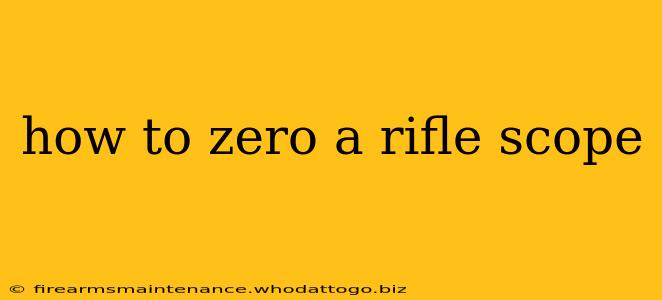Zeroing your rifle scope is crucial for accurate shooting. Whether you're a seasoned hunter or a new marksman, understanding how to properly zero your scope ensures you hit your target consistently. This guide provides a step-by-step process, covering everything from preparation to troubleshooting.
Before You Begin: Essential Preparations
Before you even touch your rifle, make sure you have the following:
- A Safe and Controlled Environment: Find a safe shooting range with a known distance (ideally 25 yards for initial zeroing, then 100 yards for fine-tuning). Ensure you have a backstop capable of stopping your projectile safely. Never shoot at anything you haven't positively identified.
- Proper Safety Gear: This includes eye and ear protection. Treat every firearm as if it were loaded.
- Shooting Rest: A stable shooting rest (sandbags, bipod, shooting bench) is essential for consistent results. Any movement during the zeroing process will negatively impact your accuracy.
- Ammunition: Use the same type and lot of ammunition throughout the zeroing process. Variations in ammunition can affect bullet trajectory.
- Tools: You might need a screwdriver (or other tools specific to your scope) for making adjustments.
- Target: A clearly marked target, preferably with distinct aiming points, is crucial. Consider using a target specifically designed for zeroing rifles.
- Detailed Records: Keep track of your shots. Note the wind conditions, and the adjustments you made after each shot. This will be invaluable for future reference.
Step-by-Step Zeroing Process
1. Mounting Your Scope: Ensure your scope is correctly mounted to your rifle. A loose or improperly mounted scope will render your zeroing efforts futile. Follow the manufacturer's instructions precisely.
2. Initial Sight-In (25 Yards):
- Get Comfortable: Find a stable shooting position and ensure you're comfortable behind the rifle.
- First Shot: Take a careful shot at the center of your target.
- Assess Impact: Note where your bullet landed on the target.
- Adjustments: Use your scope's adjustment turrets to correct your point of impact. Most scopes use a system where moving the turret up moves the point of impact up, and moving the turret right moves the point of impact right (check your scope's manual). Small adjustments are key—start with ¼ to ½ MOA (Minute of Angle) clicks.
- Repeat: Continue shooting and adjusting until your point of impact is consistently near the center of your target.
3. Fine-Tuning (100 Yards):
Once your scope is roughly zeroed at 25 yards, move to a 100-yard range. This distance will reveal any inconsistencies in your zero. Repeat the process of shooting, assessing, and making adjustments as needed. At this distance, even smaller adjustments can make a significant difference.
4. Verify Zero: After making adjustments at 100 yards, shoot several groups to confirm your scope is zeroed. If needed, perform additional small adjustments.
5. Record Your Data: Keep a record of the type of ammunition used, the distance, the weather conditions, and the final adjustments made to your scope. This record will be invaluable if you need to re-zero your scope in the future or if you change ammunition.
Understanding Scope Adjustment Turrets
Most rifle scopes use MOA (Minute of Angle) or Mil-Rad (Milliradian) adjustments. Understanding these units is critical for making accurate adjustments.
- MOA: One MOA equals approximately one inch at 100 yards.
- Mil-Rad: One Mil-Rad is approximately 3.6 inches at 100 yards.
Your scope's manual will specify the adjustment increments per click. Pay close attention to the direction of movement for your adjustments (e.g., clockwise increases elevation, counterclockwise decreases).
Troubleshooting Common Issues
- Consistent misses to one side: This likely indicates an issue with your scope mounting or a problem with the scope itself.
- Large groups (poor accuracy): This can be caused by several factors: improper shooting technique, poor ammunition, a faulty scope, or a poorly mounted scope.
- Difficulty zeroing: Ensure you're following proper shooting technique and using a stable rest.
Conclusion
Zeroing your rifle scope is a crucial skill for any shooter. By following these steps and paying attention to detail, you can achieve a consistent and accurate zero, improving your shooting performance and confidence. Remember safety is paramount – always prioritize safe gun handling practices.

